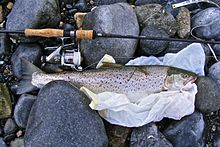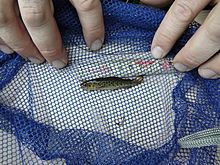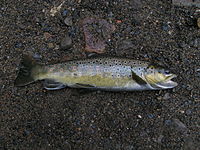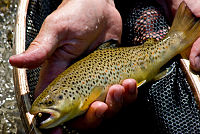
Brown trout
Did you know...
This selection is made for schools by a children's charity read more. All children available for child sponsorship from SOS Children are looked after in a family home by the charity. Read more...
| Brown trout | |
|---|---|
 |
|
| Conservation status | |
 Least Concern ( IUCN 3.1) |
|
| Scientific classification | |
| Kingdom: | Animalia |
| Phylum: | Chordata |
| Class: | Actinopterygii |
| Order: | Salmoniformes |
| Family: | Salmonidae |
| Genus: | Salmo |
| Species: | Salmo trutta |
| Binomial name | |
| Salmo trutta Linnaeus, 1758 |
|
| Morphs | |
|
Salmo trutta morpha trutta |
|
The brown trout (Salmo trutta) is an originally European species of salmonid fish. It includes both purely freshwater populations, referred to Salmo trutta morpha fario and S. trutta morpha lacustris, and anadromous forms known as the sea trout, S. trutta morpha trutta. The latter migrates to the oceans for much of its life and returns to freshwater only to spawn. Sea trout in the UK and Ireland have many regional names, including sewin (Wales), finnock (Scotland), peal (West Country), mort (North West England) and white trout (Ireland).
The specific epithet trutta derives from the Latin trutta, meaning, literally, "trout".
The lacustrine morph of brown trout is most usually potamodromous, migrating from lakes into rivers or streams to spawn, although evidence indicates stocks spawn on wind-swept shorelines of lakes. S. trutta morpha fario forms stream-resident populations, typically in alpine streams, but sometimes in larger rivers. Anadromous and nonanadromous morphs coexisting in the same river appear not to be genetically distinct. What determines whether or not they migrate remains unknown.
Range
The brown trout is normally considered to be native to Europe, Asia and south of Chile, but the natural distribution of the migratory forms may be, in fact, circumpolar. Landlocked populations also occur far from the oceans, for example in Greece and Estonia.
Conservation status
The fish is not considered to be endangered, although, in some cases, individual stocks are under various degrees of stress mainly through habitat degradation, overharvest and artificial propagation leading to introgression. Increased frequency of excessively warm water temperatures in high summer causes a reduction in dissolved oxygen levels which can cause 'summer kills' of local populations if temperatures remain high for sufficient duration and deeper/cooler or fast, turbulent more oxygenated water is not accessible to the fish. This phenomenon can be further exacerbated by eutrophication of rivers due to pollution - often from the use of agricultural fertilizers within the drainage basin.
Overfishing is a problem where anglers fail to identify and return mature female fish into the lake or stream. Each large female removed can result in thousands fewer eggs released back into the system when the remaining fish spawn.
Another threat is other introduced organisms. For example in Canada's Bow River, a non-native alga Didymosphenia geminata - common name rock snot (due to appearance) - has resulted in reduced circulation of water amongst the substrate of the river bed in affected areas. This, in turn, can greatly reduce the number of trout eggs which survive to hatch. Over time, this leads to reduction of the population of adult fish in the areas affected by the algae, forming a circle of decline. Rock snot is believed to have spread accidentally on the soles of the footwear of visitors from areas where the alga is native. The wide variety of issues that adversely affect brown trout throughout its range do not exclusively affect brown trout, but affect many or all species within a water body, thus altering the ecosystem in which the trout reside.
In small streams, brown trout are important predators of macroinvertebrates, and declining brown trout populations in these specific areas would affect the entire aquatic food web. S. trutta morpha fario prefers cold (though in comparison with other "trout", this species has a somewhat higher temperature preference of about 60-65°F, or 15.5-18.3°C), and well-oxygenated upland waters, especially large streams in mountainous areas.
Cover or structure is important to trout, and they are more likely to be found near submerged rocks & logs, undercut banks, and overhanging vegetation. Structure provides protection from predators, bright sunlight, and higher water temperatures. Access to deep water for protection in winter freezes, or fast water for protection from low oxygen levels in summer are also ideal. Trout are more often found in heavy and strong currents.
Characteristics


The brown trout is a medium-sized fish, growing to 20 kg or more in some localities, although in many smaller rivers, a mature weight of 1 kg (2 lb) or less is common. The spawning behaviour of brown trout is similar to that of the closely related Atlantic salmon. A typical female produces about 2,000 eggs per kilogram (900 eggs per pound) of body weight at spawning. On Sept. 11, 2009, a 41.45-lb (18.80-kg) brown trout was caught by Tom Healy in the Manistee River system in Michigan, setting a new state record. As of late December 2009, the fish captured by Mr. Healy was confirmed by both the International Game Fish Association and the Fresh Water Fishing Hall of Fame as the new all-tackle world record for the species. This fish now supplants the former world record from the Little Red River in Arkansas.
Brown trout can live to ages of 20 years. But as with the Atlantic salmon, a high proportion of males die after spawning, and probably fewer than 20% of anadromous female kelts recover from spawning. The migratory forms grow to significantly larger sizes for their age due to abundant forage fish in the waters where they spend most of their lives. Sea trout are more commonly female in less nutrient rich rivers. Brown trout are active both by day and by night and are opportunistic feeders. While in fresh water, their diets will frequently include invertebrates from the streambed, other fish, frogs, mice, birds, and insects flying near the water's surface. The high dietary reliance upon insect larvae, pupae, nymphs and adults is what allows trout to be a favoured target for fly fishing. Sea trout are especially fished for at night using wet flies. Brown trout can be caught with lures such as spoons, spinners, jigs, plugs, plastic worm imitations, and live or dead baitfish. Freshwater brown trout range in colour from largely silver with relatively few spots and a white belly, to the more well-known brassy brown cast fading to creamy white on the fish's belly, with medium-sized spots surrounded by lighter halos. The more silver forms can be mistaken for rainbow trout. Regional variants include the so-called " Loch Leven" trout, distinguished by larger fins, a slimmer body, and heavy black spotting, but lacking red spots. The continental European strain features a lighter golden cast with some red spotting and fewer dark spots. Notably, both strains can show considerable individual variation from this general description. Early stocking efforts in the United States used fish taken from Scotland and Germany. The Loch Leven strain is more often found in the western United States, while the "German brown" is found more toward the Midwest and East.
Brown trout rarely form hybrids with other species; if they do, they are almost invariably infertile. One such example is the tiger trout, a hybrid with the brook trout.
Diet
Young brown trout feed on insects and other invertebrates such as shrimp, caddisflies, stoneflies, and mayflies. Both larvae and adults are taken, and the fish will eat whatever local insect life is abundant at the time. Larger fish are active predators of fish including young brown trout, suckers, sculpins, shad, whitefish and Larger brown trout will also feed on small terrestrial animals that fall into the water, such as baby birds falling from overhanging nests, or even swimming mice or voles. Brown trout sometimes do not actively feed until the late afternoon or early evening, but when the weather is cool, they will feed during the day, as well. The largest browns feed under cover of darkness. Brown trout can be caught with artificial flies, jigs, rubber worms, spinners and other lures.
Stocking, farming and non-native brown trout

The species has been widely introduced for sport fishing into North America, South America, Australia, New Zealand and many other countries, including Bhutan, where they are the focus of a specialised fly fishery. First planting in the United States occurred April 11, 1884 into the Baldwin River, one mile east of Baldwin, MI. Brown trout have had serious negative impacts on upland native fish species in some of the countries where they have been introduced, particularly Australia. Because of the trout's importance as a food and game fish, it has been artificially propagated and stocked in many places in its range, and fully natural populations (uncontaminated by allopatric genomes) probably exist only in isolated places, for example in Corsica or in high alpine valleys on the European mainland.
Farming of brown trout has included the production of infertile triploid fish by increasing the water temperature just after fertilisation of eggs, or more reliably by a process known as pressure shocking. Triploids are favoured by anglers because they grow faster and larger than diploid trout. Proponents of stocking triploids argue, because they are infertile, they can be introduced into an environment that contains wild brown trout without the negative effects of cross-breeding. However, stocking triploids may damage wild stocks in other ways. Triploids certainly compete with diploid fish for food, space and other resources. They could also be more aggressive than diploid fish and they may disturb spawning behaviour.
Scottish and Irish sea trout populations in recent years have seriously declined, possibly due to infestation by sea lice from salmon farms.



